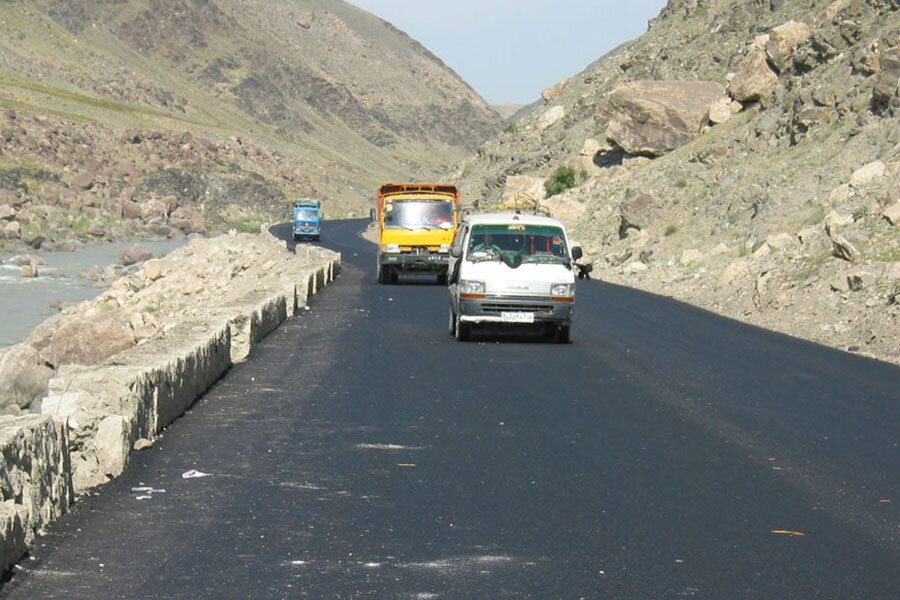Paved roads a positive legacy of Afghan war. But who fixes potholes?
Loading...
| Kabul, Afghanistan
For most of Mohammed Tahir’s 68 years, he lived on an unpaved strip of road in Afghanistan’s capital that had no drainage. Most winters he navigated the freezing mud barefoot rather than ruin his shoes in ankle-deep slush. He remembers when taxis refused to drive down the road to pick up family members during medical emergencies.
“They all said the roads were too bumpy for their cars,” Mr. Tahir recalls.
Yet about 10 months ago Tahir’s street finally got paved, the result of a collaboration between the Afghan government and Japan. Like many Afghans, especially those in Kabul, Tahir has seen his life radically change thanks to paved roads.
In 2001, Afghanistan had less than 50 miles of paved roads. Today, 8,000 to 10,000 miles of Afghanistan’s roads have been rehabilitated or improved. In Kabul alone, the mayor’s office estimates some 575 miles roads have been paved in the greater metropolitan area, with plans for more in the coming year. The international community bankrolled much of the paving, with the US alone contributing $2.36 billion.
The roads, a legacy of the 13-year US-led war against the Taliban, have eliminated many longstanding problems that added a layer of misery to a country in conflict since the early 1980s. The paving efforts have not been perfect, even failing in some places. But they have connected and transformed a number of cities and their commerce. Major roadways like the Kabul-Kandahar highway turned what used to be overnight journeys into manageable day trips.
Despite these improvements, many roads built in the early phase of the war are now in disrepair with severe potholes, both from wear and tear, as well as from roadside bombs in insecure areas. The World Bank now estimates that 85 percent of Afghanistan’s roads are in “poor shape and the majority cannot be used by motor vehicles.”
Maintaining roads and highways has so far proven an unsustainable domestic challenge. Regulating the large, overloaded trucks that use the roads and wear them down has been difficult; today many of Kabul’s streets are in dire need of mending.
Yet among those living on newly built roads in Kabul, the fresh pavement has changed lives. On Tahir’s fresh street, new sewer and drainage systems were built along with the roads. They stop homes from flooding in the winter and eliminate pools of water that attract swarms of mosquitos in the summer.
Gulnama, an Afghan housewife, says that dirt roads were worse for women. Unlike men, women don't have the option to roll up their pants and take off their shoes to walk through the mud because of cultural restrictions. The markets and shops along the road used to be virtually off limits to them during rain and snowfall.
“In the winter we would avoid going shopping there and many other women felt this way, because if we fell in the mud it would cause us great shame and people would laugh at us,” says Gulnama, who like many Afghans only has one name.
Paved roads have helped shopkeepers lower prices. Previously, delivery trucks charged a premium to traverse the pockmarked, rutted dirt road in this northeast corner of Kabul. Now merchants say the smooth road has cut transport costs, allowing them to reduce prices, carry a wider variety of products, and make more sales.
Progress in road travel and business has allowed grocer Shakib Hamidi to upgrade his commute to work. “In the past I used to have a bicycle. Now I have a motorcycle,” he says.
Further down the road, Ramatullah, who has maintained a small convenience shop for 12 years, is less impressed. As the roadwork finished, he says, the nation fell into a protracted electoral dispute and foreign forces ended their combat mission. Like most Afghans, Ramatullah says the times are now hard on business and predicts it will take more than a paved road to improve sales.
“There are not enough jobs for everyone,” he says. “Now I get customers coming from further away because of this road, but people don’t have money anymore.”








